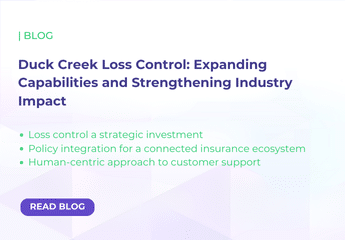Proactive, efficient claims management is arguably the most critical component of an insurers’ ability to protect their customers and themselves. To be successful in this element of operations, many carriers are utilizing new claims technology and moving to digital claims processing.
But how? As part of the ongoing digital transformation of the insurance industry, many have implemented digital or automated solutions that touch all areas of insurance functions. In fact, it is generally estimated that 60% to 70% of claims can be handled in a fully automated fashion. To separate themselves from their competitors and elevate the customer experience, insurers must integrate these technologies — including digital claims — into their operations to keep pace.
What Are Digital Claims?
Digital claims, or the solutions that allow for them, are claims management programs that allow insurers to manage the entire claims lifecycle in a single solution. In the digital claims ecosystem, insurers can oversee every step in the claims process from the first notice of loss to the final settlement in a centralized, efficient, and organized program.
Digital claims allow insurers to provide a premium service to their customers, during what can be their biggest time of need. Modern customers expect nearly instant, seamless communication and feedback, and digital claims allows for most interactions to be automated. What’s more, customers can handle their business 24/7, which provides an added level of convenience and speed.
Why Switch to Digital Claims
Switching to digital claims management will not only improve customer-facing operations, it can also benefit insurers internally. A few of the top reasons why insurers should switch to digital claims include:
- Increased claims efficiency: Today’s claims technology makes it possible to streamline traditionally disjointed claims management practices, which can result in drastically faster processing and reduced claims cycle times. With dynamically guided workflows and automation, claims are processed in a fraction of the time. By freeing up agents, insurers can empower their claims employees to focus on delivering optimal customer service and positive outcomes.
- Improved customer experiences: With digital claims, insurers can improve customer service while lowering expenses with automated tools. These automated processes can manage the investigation to the point of loss and reduce claim cycle times, thereby getting customers their settlement faster and giving them a better overall experience. The technology that makes digital claims possible is part of a comprehensive digital insurance ecosystem that can deliver personalized, transparent, and effective communications with policyholders wherever and however they want. And according to Bain and Co., 61% of policy-holders will switch insurers to find better ecosystem services.
- Modernized operations and faster innovation: According to a PwC report, 67% of insurance CEOs see innovation as very important to their organizations. The speed with which insurers can innovate and introduce new products to market is a major component of success. And with claims technologies, insurers can modernize many facets of their operations, which causes a domino effect where other insurance functions — including product development — can also be improved.
How to Leverage Big Data & Artificial Intelligence for Digital Claims
With seemingly endless options when it comes to mobile technologies, artificial intelligence (AI), and machine learning capabilities, insurers can unlock significant value by employing a new, modern claims processing workflow.
First, AI can tackle many facets of claims processing and is a major reason why many steps in the process can be automated. Secondly, the volume of data generated during the claims process (which is captured and analyzed by AI), can unlock new insights and inform nearly every facet of insurance operations.
Some of the primary ways insurers can utilize AI and big data in the digital claims process include:
- Damage assessment: Insurers and customers can communicate about and work through the initial stages of the claims process using AI technology. Using just a mobile app, customers can take photos and video of damage, which is then processed by AI technology in a mobile application.
- Customer interaction: Chatbots are now playing a vital role during the initial reporting of a claim. This allows customers to report incidents anytime, anyplace, and can begin the process much faster than before. There is also great potential to use chatbots throughout the claim process to improve communications and cycle times.
- Fraud detection/management: AI and machine learning provide much needed new capabilities for the early identification of potential fraud, as well as new tools for fraud investigators. With real-time data and other new data processing, AI can detect fraudulent behavior and alert insurers before any money is lost.
Benefits of Digital Claims
Having claims information digitally available and orchestrated by a modern claims system can benefit insurers in a number of ways. With digital claims, carriers can achieve:
- Faster Claims Processing. Claims automation processing times can be drastically sped up by leveraging the increasing amounts of information gathered on-site by claimants. Relevant information such as type of claim, severity, elements, and injury all can be used to route claims to the right person or, perhaps, even complete claims in a touchless manner.
- Loyal Customers. Digital claims can improve customer loyalty, largely because this data can be leveraged to give carriers better insight into customer data. In today’s digital world, carriers are moving to make their interaction personalized to improve customer satisfaction.
Better Analysis. Better analysis is beneficial to the carrier from a loss standpoint, and it can lead to greater trust in customers, which ultimately results in improved customer satisfaction. And, when carriers implement advanced analysis, fraud detection also improves.
How to Successfully Make the Digital Claims Transformation
The insurance-claims journey, from prevention, to first notice of loss, to investigation, and finally settlement, can be difficult and confusing to customers. To determine how digital technologies can unlock value and improve the claims customer journey from start to finish, companies need to examine each step of the journey and start to develop a game plan to make the process more seamless.
Common best practices for implementation include:
- Declare objectives and guiding principles up front. Running transformative projects — like moving to digital claims — while simultaneously running a successful business means tough decisions and tradeoffs will happen. To help make this process go as smoothly as possible, make sure all stakeholders have a clear picture on what a transformed claims process and ecosystem look like. As issues arise, having guiding principles to refer back to, such as “the customer experience must be easy,” will help prioritize choices and ensure the final project meets objectives.
- Hold a discovery workshop. While most insurers are aware that they need to update their current system, it is often challenging to identify every item that needs improvement. Holding workshops to analyze the current state and define new objectives makes it much easier to take obsolete claims products and processes and transform them into a new, efficient system. This process makes it much easier to identify the work that needs to be completed. Plus, when the new claims system is complete, user adoption can be improved because end users can understand where they came from and what the new system provides.
- Define project scope. As with any project, undefined scope can jeopardize the success of the project. When moving to digital claims, once the objectives are defined — faster processing and additional data through integrations or automation — make sure the scope remains tied to objectives.
- Test and learn. It is critical to involve end users early in the process. Adjusters, for example, who will be in the system regularly, should provide feedback as the system is being configured. Small items, like easy access to claim notes, could make a significant difference to adoption.
Digital claims can be a one-off solution, or they can be part of a larger insurance digital transformation. Depending on your needs and future goals, look for products that work as part of a larger digital ecosystem that can be scaled up and modernized easily. Cloud-based insurance technology is ideal for these capabilities, as they are essentially evergreen solutions that will continue to evolve as technology and the industry grow and develop.




